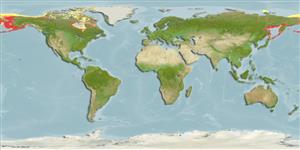Environment: milieu / climate zone / depth range / distribution range
Οικολογία
Θαλασσινό(ά) βενθικό(ς); εύρος βάθους 0 - 100 m (Ref. 50550), usually 10 - 70 m (Ref. 56527). Temperate; 88°N - 40°N, 135°E - 60°W
North Pacific: Hokkaido, Japan and Sea of Okhotsk to the Bering Sea. Arctic Canada.
Μέγεθος / Βάρος / Age
Maturity: Lm ? range ? - ? cm
Max length : 112 cm TL αρσενικό/απροσδιόριστο; (Ref. 56527)
Ραχιαίες άκανθες (συνολικά): 83 - 88; Εδρικές άκανθες 0; Μαλακές εδρικές ακτίνες: 53 - 54. Four pairs of strong canines on anterior parts of both jaws; molar teeth on prevomerine and palatal bones and posterior part of lower jaw. Dorsal fin without soft rays. Pelvic fins absent.
Found on rocky bottoms (Ref. 559). Benthic (Ref. 58426). Feeds on hard-shelled invertebrates (Ref. 28499).
Life cycle and mating behavior
Γεννητική Ωρίμανση | Αναπαραγωγή | Γεννοβολία | Αβγά | Γονιμότητα | Προνύμφες
Eggs are very large.
Masuda, H., K. Amaoka, C. Araga, T. Uyeno and T. Yoshino, 1984. The fishes of the Japanese Archipelago. Vol. 1. Tokai University Press, Tokyo, Japan. 437 p. (text). (Ref. 559)
IUCN Red List Status (Ref. 130435)
Threat to humans
Harmless
Human uses
Περισσότερες πληροφορίες
ΑναφορέςΥδατοκαλλιέργειεςΠροφίλ υδατοκαλλιέργειαςΣτελέχοιΓενετικήElectrophoresesΚληρονομικότηταΑσθένειεςΜεταποίησηNutrientsMass conversion
ΣυνεργάτεςΦωτογραφίεςStamps, Coins Misc.ΉχοιΣιγκουατέραΤαχύτηταΚολυμβητικός ΤύποςΕπιφάνεια βραγχίωνOtolithsΕγκέφαλοιΌραση
Εργαλεία
Special reports
Download XML
Διαδικτυακές πηγές
Estimates based on models
Preferred temperature (Ref.
123201): -0.6 - 6.9, mean 2.3 °C (based on 1276 cells).
Phylogenetic diversity index (Ref.
82804): PD
50 = 0.5938 [Uniqueness, from 0.5 = low to 2.0 = high].
Bayesian length-weight: a=0.00398 (0.00174 - 0.00913), b=3.17 (2.97 - 3.37), in cm total length, based on LWR estimates for this (Sub)family-body shape (Ref.
93245).
Τροφικό Επίπεδο (Ref.
69278): 3.8 ±0.4 se; based on diet studies.
Ελαστικότητα (Ref.
120179): Χαμηλό, ελάχιστος χρόνος για διπλασιασμό πληθυσμού 4,5 - 14 έτη (Assuming tm>5).
Fishing Vulnerability (Ref.
59153): High to very high vulnerability (67 of 100).
